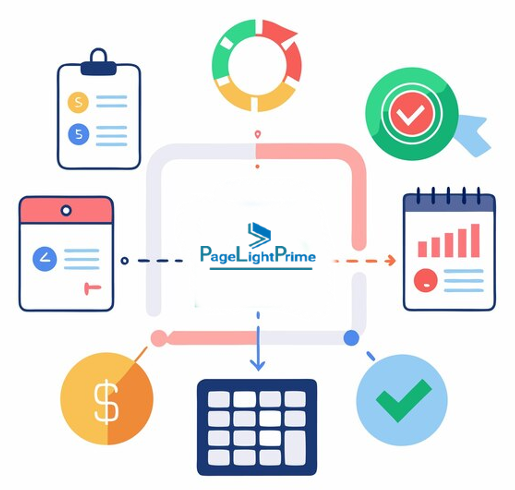Trust Account Reconciliation for Law Firms: A Comprehensive Guide
Trust account reconciliation is a crucial financial management practice for law firms that handle client funds. It ensures that all transactions are properly accounted for, maintaining compliance with legal and ethical guidelines. Accurate reconciliation helps law firms avoid costly mistakes, penalties, or even disbarment. In this guide, we’ll explore the key aspects of trust account reconciliation, including the three-way reconciliation process, common challenges, and the role of trust account reconciliation software in streamlining this essential task.
Written by Knowledge Team, posted on Oct 25, 2024

Three-Way Reconciliation
The most vital part of trust account reconciliation is the three-way reconciliation process for law firms. This method ensures that the firm’s financial records match both client-specific records and the bank’s verification. It involves reconciling three separate records:
Trust Ledger (Internal Books)
This internal record tracks all transactions into and out of the trust account, documenting deposits, withdrawals, and other activities.
Client Ledgers
Each client’s ledger provides a detailed breakdown of that client’s transactions, ensuring proper allocation of funds.
Trust Account Bank Statement
The bank statement offers third-party verification of all trust account transactions, ensuring the firm’s internal records match those held by the bank.
The three-way reconciliation process is essential because it safeguards against errors, fraud, and non-compliance by comparing internal records with third-party verification.

Reconciliation Process
Performing a three-way reconciliation involves several basic steps.
Reconcile the Bank Statement with Internal Records
Compare the transactions listed in the trust ledger with the trust account bank statement to ensure they match.
Compare the Trust Ledger Balance to the Reconciled Bank Statement
Once the transactions are verified, check that the overall balance in the trust ledger aligns with the bank statement.
Reconcile the Bank Statement with Client Ledgers
Finally, compare the trust bank statement to individual client ledgers, confirming that each client’s funds are properly accounted for.
Regular reconciliation of these records is crucial for maintaining compliance and protecting client funds.

Key Components of Trust Account Reconciliation
The three primary components involved in trust account reconciliation are:
Trust Ledger
This is the firm’s internal record of all trust accounting activities, which must be accurate and up to date.
Client Ledgers
Each client’s ledger records transactions specific to that client, preventing commingling of funds.
Trust Account Bank Statement
This statement provides external verification of all trust account transactions, ensuring accuracy and compliance.

Differences Between Pooled and Separate Trust Accounts
Law firms typically manage client funds using either pooled trust accounts or separate trust accounts, each with different reconciliation challenges.
Pooled Trust Accounts
These accounts consolidate funds from multiple clients into one account. Law firms must keep detailed records to track individual client balances within the pooled account. This requires meticulous attention during reconciliation to ensure no funds are improperly allocated between clients. Trust account reconciliation software can help automate this process by tracking client-specific transactions.
Separate Trust Accounts
In contrast, some firms may use separate accounts for individual clients, especially when handling large sums or in compliance with certain legal requirements. While this simplifies reconciliation for each account, managing multiple accounts can increase administrative overhead.

Common Challenges Law Firms Face During Trust Account Reconciliation
Law firms often encounter challenges in maintaining accurate trust account reconciliations. Here are some common trust account mistakes:
Complexity of Pooled Accounts
Tracking multiple clients’ funds within a single account can lead to errors in allocation, making reconciliation more difficult.
Human Error
Manual data entry increases the risk of mistakes in recording transactions, which can lead to discrepancies during reconciliation.
Inconsistent Record Keeping
Incomplete or inaccurate documentation can complicate the reconciliation process and cause delays in identifying issues.

Overdrawn Client Accounts
Drawing more funds than are available from a client’s trust account is a serious violation and can occur when records are not accurately maintained.
Failure to Reconcile Regularly
Delaying reconciliations increases the risk of accumulating errors and makes discrepancies harder to track and correct.
Trust account reconciliation software can address these challenges by automating the process, reducing human error, and providing real-time updates to ensure accuracy and compliance.

How Often Should Trust Account Reconciliation Be Performed?
The frequency of trust account reconciliations varies by jurisdiction, but most bar associations, including the American Bar Association (ABA), recommend monthly reconciliations. Performing automated trust account reconciliation monthly helps identify discrepancies early, reducing the risk of major issues. In some jurisdictions, quarterly reconciliations are permissible, but monthly reconciliations are considered the best practice to minimize errors and maintain compliance.

Consequences of Non-Compliance with Trust Account Reconciliation
Non-compliance with trust account reconciliation can result in significant consequences:
Legal Penalties and Fines
Law firms that fail to comply with trust account regulations may face fines from regulatory bodies and state bar associations.
Professional Sanctions
Trust account violations can lead to disciplinary action, including suspension or disbarment, jeopardizing a lawyer’s career.
Loss of Client Trust
Mismanagement of client funds can damage the firm’s reputation, leading to loss of business and even lawsuits.
Increased Scrutiny
Non-compliance often results in more frequent audits and increased oversight from regulators, adding administrative burdens.

The Role of Technology: Trust Account Reconciliation Software
Technology has revolutionized trust account reconciliation, with legal accounting software offering numerous benefits for law firms. Here’s how automated trust account reconciliation can simplify the process:
Automated Reconciliation Tools
Software solutions integrate with bank accounts and client management systems to automatically reconcile trust ledgers, client ledgers, and bank statements. This significantly reduces the risk of human error and saves time.
Error Detection and Alerts
Advanced reconciliation software can flag discrepancies or overdrawn accounts, alerting firms to potential issues before they escalate.
Compliance Tracking
Many trust account reconciliation software tools are designed with compliance in mind, helping law firms stay on top of jurisdictional requirements by generating accurate reports and maintaining up-to-date records.
Cloud-Based Solutions
Cloud-based legal trust accounting software allows law firms to manage their trust accounts in real-time, from anywhere. These platforms provide a centralized dashboard for monitoring client funds, ensuring seamless collaboration across teams.

Law Firm Trust Account Best Practices
In addition to using technology, law firms should adopt trust account best practices to maintain compliance and accuracy. These include:
Reconcile Accounts Monthly
Performing reconciliations monthly ensures that any discrepancies are caught early, minimizing the risk of non-compliance.
Establish Clear Procedures
Clearly define roles and responsibilities for trust account management within the firm. This ensures accountability and consistency in how client funds are handled.
Maintain Accurate Documentation
Keeping detailed records of every transaction is essential for accurate reconciliations. Use software to centralize documentation and ensure nothing is overlooked.
Train Staff on Compliance
Ensure that all staff members handling trust accounts are trained on best practices and familiar with the regulations governing trust account management.

Conclusion
“
Trust account reconciliation is an indispensable process for law firms to ensure the proper handling of client funds and remain compliant with legal obligations. The three-way reconciliation process, which compares trust ledgers, client ledgers, and bank statements, is the cornerstone of trust account management. By leveraging automated trust account reconciliation software, law firms can reduce the risk of errors, simplify the reconciliation process, and ensure compliance with regulatory standards. Implementing best practices for trust account management ensure that law firms can maintain client trust, avoid legal penalties, and uphold their fiduciary responsibilities.
Incorporating technology into trust account reconciliation not only saves time but also enhances accuracy, making it an essential tool for modern law firms.
“
Frequently Asked Questions (FAQ)
Are there advanced reconciliation techniques beyond the three-way process
Yes, there are. Some law firms may use more sophisticated tools or methods, such as:
Automated reconciliation software: This can significantly reduce human error and improve efficiency.
Data analytics: Analyzing transaction patterns and historical data can help identify potential discrepancies or anomalies.
Reconciliation software with AI capabilities: AI can automate tasks, detect errors, and even suggest corrective actions.
What are the ethical considerations in trust account management
Law firms have a fiduciary duty to protect client funds. Ethical considerations include:
Preventing the commingling of funds: Client funds must be kept separate from the firm's operating funds.
Avoiding overdrafts: Ensuring that there are sufficient funds in client accounts to cover withdrawals.
Promptly disbursing funds: Client funds should be disbursed as soon as possible upon request.
Maintaining accurate records: Detailed records of all trust account transactions are essential for compliance and accountability.
What are the potential consequences of non-compliance with trust account reconciliation
Non-compliance can lead to:
Legal penalties and fines: Regulatory bodies may impose financial penalties.
Professional sanctions: Lawyers may face disciplinary action, including suspension or disbarment.
Loss of client trust: Mismanagement of client funds can damage a firm's reputation.
Increased scrutiny: Non-compliance may result in more frequent audits and oversight.
How can trust account reconciliation software be integrated with other law firm systems
Integration with other systems, such as case management software or law firm management software, can streamline operations and improve efficiency. This can include:
Automated data transfer: Information can be automatically transferred between systems, reducing manual data entry and the risk of errors.
Real-time updates: Changes in one system can be reflected in others, ensuring that all records are consistent.
Centralized reporting: Reports can be generated from multiple systems, providing a comprehensive overview of trust account activity.
